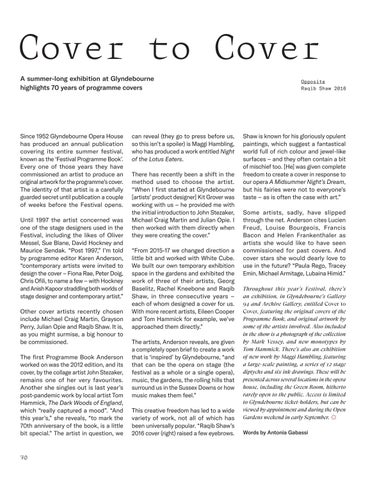Cover to Cover A summer-long exhibition at Glyndebourne highlights 70 years of programme covers
Since 1952 Glyndebourne Opera House has produced an annual publication covering its entire summer festival, known as the ‘Festival Programme Book’. Every one of those years they have commissioned an artist to produce an original artwork for the programme’s cover. The identity of that artist is a carefully guarded secret until publication a couple of weeks before the Festival opens. Until 1997 the artist concerned was one of the stage designers used in the Festival, including the likes of Oliver Messel, Sue Blane, David Hockney and Maurice Sendak. “Post 1997,” I’m told by programme editor Karen Anderson, “contemporary artists were invited to design the cover – Fiona Rae, Peter Doig, Chris Ofili, to name a few – with Hockney and Anish Kapoor straddling both worlds of stage designer and contemporary artist.” Other cover artists recently chosen include Michael Craig Martin, Grayson Perry, Julian Opie and Raqib Shaw. It is, as you might surmise, a big honour to be commissioned. The first Programme Book Anderson worked on was the 2012 edition, and its cover, by the collage artist John Stezaker, remains one of her very favourites. Another she singles out is last year’s post-pandemic work by local artist Tom Hammick, The Dark Woods of England, which “really captured a mood”. “And this year’s,” she reveals, “to mark the 70th anniversary of the book, is a little bit special.” The artist in question, we
70
can reveal (they go to press before us, so this isn’t a spoiler) is Maggi Hambling, who has produced a work entitled Night of the Lotus Eaters. There has recently been a shift in the method used to choose the artist. “When I first started at Glyndebourne [artists’ product designer] Kit Grover was working with us – he provided me with the initial introduction to John Stezaker, Michael Craig Martin and Julian Opie. I then worked with them directly when they were creating the cover.” “From 2015-17 we changed direction a little bit and worked with White Cube. We built our own temporary exhibition space in the gardens and exhibited the work of three of their artists, Georg Baselitz, Rachel Kneebone and Raqib Shaw, in three consecutive years – each of whom designed a cover for us. With more recent artists, Eileen Cooper and Tom Hammick for example, we’ve approached them directly.” The artists, Anderson reveals, are given a completely open brief to create a work that is ‘inspired’ by Glyndebourne, “and that can be the opera on stage (the festival as a whole or a single opera), music, the gardens, the rolling hills that surround us in the Sussex Downs or how music makes them feel.” This creative freedom has led to a wide variety of work, not all of which has been universally popular. “Raqib Shaw’s 2016 cover (right) raised a few eyebrows.
Opposite Raqib Shaw 2016
Shaw is known for his gloriously opulent paintings, which suggest a fantastical world full of rich colour and jewel-like surfaces – and they often contain a bit of mischief too. [He] was given complete freedom to create a cover in response to our opera A Midsummer Night’s Dream, but his fairies were not to everyone’s taste – as is often the case with art.” Some artists, sadly, have slipped through the net. Anderson cites Lucien Freud, Louise Bourgeois, Francis Bacon and Helen Frankenthaler as artists she would like to have seen commissioned for past covers. And cover stars she would dearly love to use in the future? “Paula Rego, Tracey Emin, Michael Armitage, Lubaina Himid.” Throughout this year’s Festival, there’s an exhibition, in Glyndebourne’s Gallery 94 and Archive Gallery, entitled Cover to Cover, featuring the original covers of the Programme Book, and original artwork by some of the artists involved. Also included in the show is a photograph of the collection by Mark Vessey, and new monotypes by Tom Hammick. There’s also an exhibition of new work by Maggi Hambling, featuring a large-scale painting, a series of 12 stage diptychs and six ink drawings. These will be presented across several locations in the opera house, including the Green Room, hitherto rarely open to the public. Access is limited to Glyndebourne ticket-holders, but can be viewed by appointment and during the Open Gardens weekend in early September. Words by Antonia Gabassi













